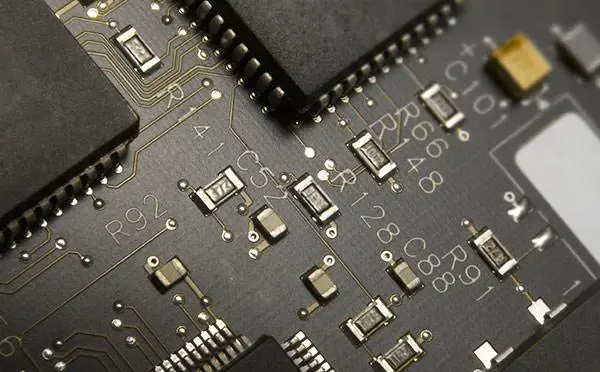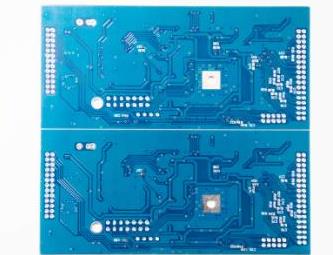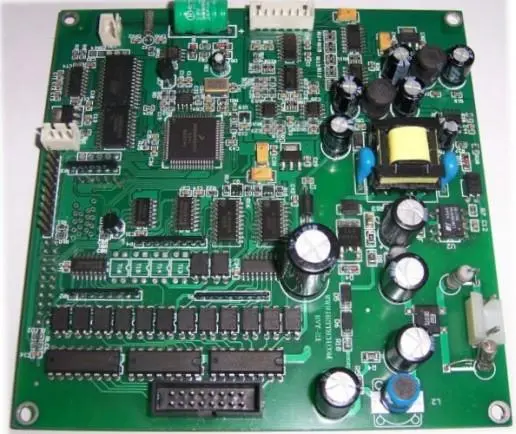
PCB electroplating will encounter many different problems, such as pinholes, pits, bottoming, tin climbing, air flow streaks, etc. The following is a summary of the description and causes of poor PCB electroplating coating based on years of experience, and a summary of dry goods to share if necessary.
PCB electroplating
Pinhole. The pinhole is due to the hydrogen adsorbed on the surface of the plating piece, which is not released for a long time. The plating solution can not wet the surface of the plating piece, so that the plating layer can not be electrodeposited. With the increase of coating thickness around the hydrogen evolution point, the hydrogen evolution point forms a pinhole. It is characterized by a shiny round hole and sometimes an upward small tail. When the bath is short of wetting agent and the current density is high, pinholes are easily formed.

2. Pits. Pitting is caused by the unclean surface to be plated, the adsorption of solid substances, or the suspension of solid substances in the plating solution. When the solid substances reach the workpiece surface under the action of electric field, they are adsorbed on it, which affects the electrodialysis. These solid substances are embedded in the electroplating layer, forming small bumps (pits). It is characterized by convexity, no brightness and no fixed shape. In short, it is caused by dirty workpiece and plating solution.
3. Air streaks. The gas flow streaks are caused by excessive additives, too high cathodic current density or too high complexing agent, which reduces the cathodic current efficiency and leads to large hydrogen evolution. If the bath flows slowly and the cathode moves slowly at that time, the process of hydrogen rising against the surface of the workpiece will affect the arrangement of electrodialysis crystals, forming streaks of air flow from bottom to top.
4. Masking (exposing the bottom). Masking is because the soft overflow on the pin part of the workpiece surface has not been removed, so it is impossible to electrodeposit the coating here. The substrate is visible after electroplating, so it is called exposed (because the soft overflow is translucent or transparent resin component).
5. The coating is brittle. After the SMD electroplating, the cut rib is formed, and cracks can be seen at the bend of the pin. When the nickel layer cracks with the matrix, it is determined that the nickel layer is brittle. When the tin layer cracks with the nickel layer, it is determined that the tin layer is brittle. The brittleness is mostly caused by excessive additives and brighteners, or too many inorganic and organic impurities in the plating solution.
6. Air bag. The air bag is formed due to the shape of the workpiece and the condition of air accumulation. Hydrogen accumulated in the "bag" cannot be discharged to the liquid level of the plating solution. The presence of hydrogen prevents the electrodeposition of the coating. Leave the area where hydrogen accumulates uncoated. During electroplating, air pockets can be avoided by paying attention to the hook direction of the workpiece. When the workpiece is electroplated as shown in the figure, when the hook is perpendicular to the bottom of the plating tank, no air bag will be generated. When hooking parallel to the bottom of the tank, it is easy to produce air bags.
7. A "tin flower" opens in the center of the plastic black body. There is tin coating on the black body. This is because the upward parabola of the gold wire is too high when the electronic tube is soldered. When the gold wire is exposed on the black body surface during plastic sealing, the tin is plated on the gold wire, like a flower. It is not the plating solution.
8. "Tin climbing". There is a tin layer at the junction (root) of the lead wire and the blackbody, which climbs up the blackbody like a wall climbing grass. The tin layer is a dendritic loose coating. This is because the SMD frame is brushed with a copper brush during the pre plating process, and the worn copper powder embedded in the black body is not easy to wash off, becoming a conductive "bridge". When electroplating, as long as the electrodialysis metal builds a "bridge", it will extend. The dendritic deposition creeps away to connect with other copper powders, and the tin climbing area is getting larger and larger.
9. The "whisker tin" is located at the junction between the lead and the blackbody. There is whisker tin on both sides of the lead, and tin coke shaped tin is located at the junction between the front of the lead and the blackbody. This is because when SMD frame is silver plated by mask method, the mask device is not tight, and silver is also plated where silver is not needed. When plastic sealing, part of the silver layer is exposed outside the black body. In the pretreatment, the silver layer is pried up, and the tin plated on the silver is like whiskers or piles of tin. Overcoming the exposure of silver layer is one of the keys of silver mask technology.
10. Orange peel coating. When the base material is very rough, or there is corrosion in the pretreatment process, or when the Ni42Fe+Cu base material is pretreated before plating, some copper layers have been removed, while some copper layers have not been removed in some areas, and the entire surface is not smooth. The above conditions may cause the orange peel state of the coating.
11. Cavity plating. There are dense and irregular pits (different from pinholes) on the surface of the coating, forming a "ceiling face" coating. There are two conditions that may form a "ceiling face" coating.
(1) Some units use the glass bead spraying method to remove the overflow. When the spraying pressure is too high, the kinetic energy inertia of the glass bead impacts the plated surface into small pits. When the coating is too thin, the pit is not filled, and it becomes the "ceiling face" coating.
(2) The alloy of the base material is not uniform in metallography, and there is selective corrosion during the pretreatment process. (The more active metal is first etched to form pits). If the cavity is not filled after electroplating, the coating of "ceiling face" will be formed.
For example: Ni42Fe base material, if Ni and Fe are not fully mixed evenly in the metallurgical process, there may be uneven alloy metallography in some areas on the material surface after rolling. In the pretreatment of plating, since Fe is more active than Ni, it is selectively preferentially etched to form pits. If the electroplating coating can not smooth the pits, it will become the "ceiling face" coating. Similarly, zinc brass has the same phenomenon. If the copper zinc metallography is uneven, zinc will selectively corrode prior to copper during pre plating treatment, making the base material pit. After electroplating, it will be a concave coating.
12. Loose dendritic coating. When the plating solution is dirty, the concentration of main metal ions is high, the complexing agent is low, the additives are low, the cathode and anode are too close to each other, and the current density is too high, so loose dendritic coating is easy to form in the current zone. Loose coating is like foam plastic, with uneven branches, and the coating can be wiped off with fingers.
13. Double layer coating. The formation of double-layer coating mostly occurs when the operating temperature of the plating solution is relatively high. During the electroplating process, the workpiece is lifted out of the plating bath and then hung into the plating bath again. In this process, if the workpiece is raised for a long time, the plating solution on the workpiece surface will precipitate salt frost and attach to the workpiece due to the evaporation of water. When the salt frost is not dissolved in time for further plating, the coating will be plated on the surface of the salt frost, forming a double-layer coating, like Huafu biscuit, with a layer of salt frost sandwiched between the two layers.
To avoid double layer coating, shake the workpiece in the plating solution for a few seconds before further plating, and then electrify for further plating after the salt frost is dissolved.
14. The coating is blackened. The main reason for the blackening of the coating is the high metal and organic impurities in the bath, especially in the low current density area; In the case of insufficient additives, black coating will also appear in the middle of large plating area; If the temperature is too low, the ion activity is small, and the gray black coating will also be formed when the current is too high. To deal with metal impurities, corrugated plate can be used as cathode for electrolysis of 01-0.2A/dm2. Organic pollution can be treated with 3-5 g/l activated carbon. Granular, washed with pure water first
15. Blunt peeling. Ni42Fe alloy is easy to be passivated. Pre plating activation includes two chemical processes, one is oxidation process, the other is oxide dissolution process. If the oxidation process is not sufficient or the oxide can not be dissolved in time, the coating will be peeling or rough if there is still oxide residue on the surface to be plated.
16. Replacement peeling. If there are two different materials on the same workpiece. For example, the surface of copper substrate is nickel plated, and copper is exposed on the cut after cutting and shearing. When the copper ion in the strong etching bath increases to a limit value, the replacement copper layer is easily generated on the nickel layer. With replacement copper, tin coating will peel after tin plating. In this case, only the strong corrosive liquid can be renewed frequently to avoid displacement peeling
17. Oil pollution peeling. If the oil in the pre plating treatment is not removed completely, the area with oil pollution during electroplating will have no coating. Even if the coating is covered, it is also a fake plating. The coating has no binding force with the substrate. Like rubella, the coating will bulge one by one and fall off once wiped.
18. Dark round spot coating. When the workpiece has a large plated area, such as the heat sink of the pipe. When there are too many impurities or insufficient additives in the bath, a gray black dark round spot coating will be formed in the center of the radiator block, just like a plaster. Because the center of the large area is a low current area, impurities are concentrated here. Or when the additive is insufficient, the depth capacity of the bath decreases.
19. The coating has uneven luster and obvious (visual) uneven thickness. This is because the additive has just been added, and the additive is not fully dispersed, so that the bath characteristics are not uniform. After the additives are uniformly dispersed, the fault will disappear naturally.
20. The chemical fiber in the plating solution is polluted. It can be seen that a filament of chemical fiber is embedded in the coating. Anode bag PP cloth can overcome this fault by iron ironing.
21. The plating solution is contaminated by mold (mostly seen in nickel plating bath, because the PH4-5 environment is suitable for mold growth). It can be seen that there are many mold cells embedded in the plating layer. In this case, disinfection and sterilization measures should be taken. In order to avoid mold pollution, attention must be paid to the implementation of the cylinder opening procedure of the production line.
22. Moss pollutes water. The work piece is rinsed in the water containing moss organisms. The moss sticks to the work piece and firmly sticks to the work piece after drying, which affects the product quality. Every spring, we should pay attention to the possibility of moss pollution and establish a sense of prevention. If moss pollutes the bath, moss will be embedded in the coating.
23. The coating has high porosity. The high porosity of the coating affects the appearance of the coating, affects the protective characteristics of the coating, shortens the storage period, affects the weldability, and the coating is brittle. Most of the causes are dirty plating solution, many metal impurities and many organic impurities. The method to identify the porosity of the coating is to directly identify the characteristics of the plating solution. Hang the polished and degreased stainless steel sheet into the electroplating area about 0.5-1H. If the coating completely encloses the stainless steel sheet, and the coating can be scraped off from the edge, the whole coating can be torn off with good toughness to form a whole coating sheet. Align the front view of the film with the sunlight. If no pores can be seen, it indicates that the characteristics of the plating solution are good. If a bit of light transmission electricity (pores) can be seen, it indicates that the characteristics of the plating solution are poor; If the coating can not be removed from the stainless steel sheet, and the coating is raised like a fish scale, it shows that the characteristics of the plating solution are very poor, and the plating solution needs major treatment.
24. The coating thickness on the same hanger varies regularly. This is because the projection of the cathode and anode figures is not correct (the relative position of the cathode and anode is not suitable), and the distribution of power lines is uneven. The coating thickness on the same rack varies regularly. This is because the hook elastic contact resistance of each workpiece is different. The thickness of the coating with good contact is the same as that of the coating with good contact. It's the quality of the rack. If there are two hangers in the same tank, one has a thick coating and the other has a thin coating, which is due to the different aging degree of the two hangers. The contact resistance of the newer hanger is small, and the coating is thick, otherwise it is. If the projection of the cathode and anode is correct, the aging degree of the two hangers is the same, but the coating thickness is thick on one side and thin on the other side, with regular changes. This is due to corrosion or salt frost on the cathode at one side, resulting in poor electrical contact. In order to ensure good conductivity on both sides of the plating bath and eliminate the defect of large voltage drop of PCB powered on on one side, both ends of the plating bath need to be powered on when the length of the plating bath is greater than 1 meter, and regular cleaning is required to maintain good electrical contact.
25. There are black stains on the surface of some PCB workpieces. There are two possible reasons for this:
(1) The rack is aging and cracking, and the acid, alkali and salt exuded from the cracks are sprayed by compressed air and splashed on the workpiece, polluting the coating.
(2) The water level of rinsing water is too low, and the workpieces on the upper layer of the rack cannot be rinsed. The workpieces and hanging teeth that cannot be rinsed are cross contaminated by drops of liquid medicine. Therefore, the rinsing liquid level must be higher than the work-piece on the top of the rack.
(3) Droplet cross contamination.
(4) There is oil in the gas.
(5) Pollution caused by manual unloading operation.
26. Discoloration (yellowing) of workpieces after plating and drying or discoloration after a short storage time are two possible conditions:
(1) The concentration of neutralization solution is too thin and the temperature is too low to remove the membrane.
(2) The crystallization of PCB coating is rough, which increases the difficulty of rinsing and removing the film.
27. There are tin nodules on the surface of PCB coating. This is because the anode mud pollutes the plating solution, and the PP bag leaks. When the anode is dissolved, on the one hand, it is transferred into the plating solution in the form of ions, and on the other hand, it is flushed into the plating solution in the form of atoms and atomic clusters, which pollutes the plating solution. When the atomic cluster contacts the workpiece, it is embedded in the coating to form a tin nodule.
28. The black body is heterochromatic. That is, the black plastic package becomes gray black. This is because the frame stays in the alkali solution for too long in the pretreatment or neutralization tank before electroplating, and the black body has been eroded by alkali. The components of the black body include epoxy, leveling agent, curing agent, anti-aging agent, white filler, melanin, etc. When the black body is corroded by alkali, the filler will be exposed. White+black is grey (heterochromatic).







